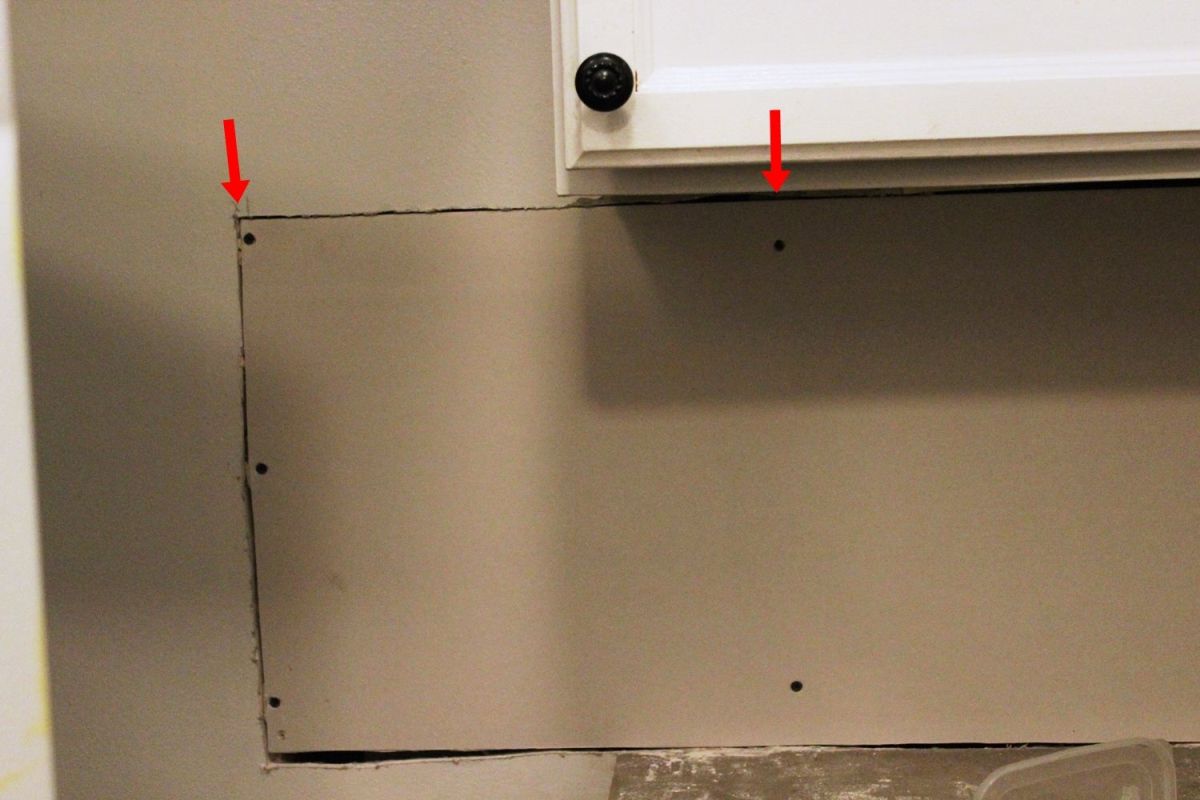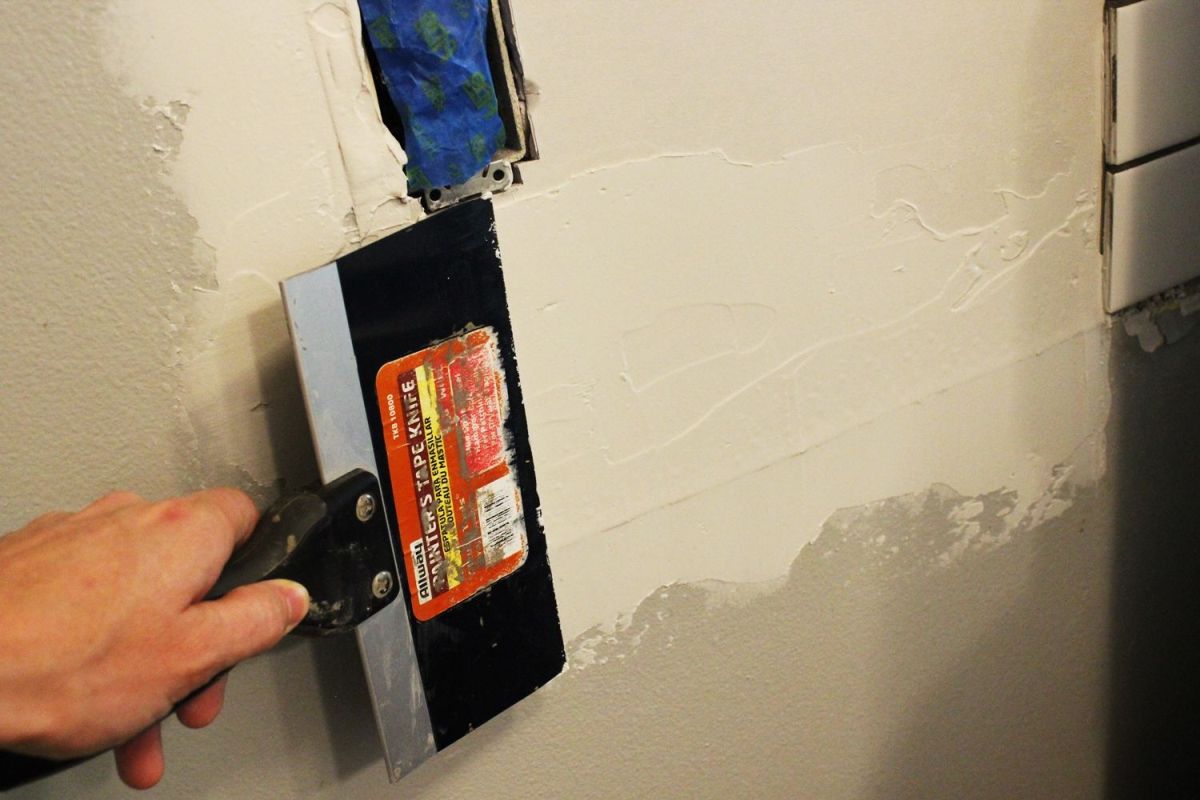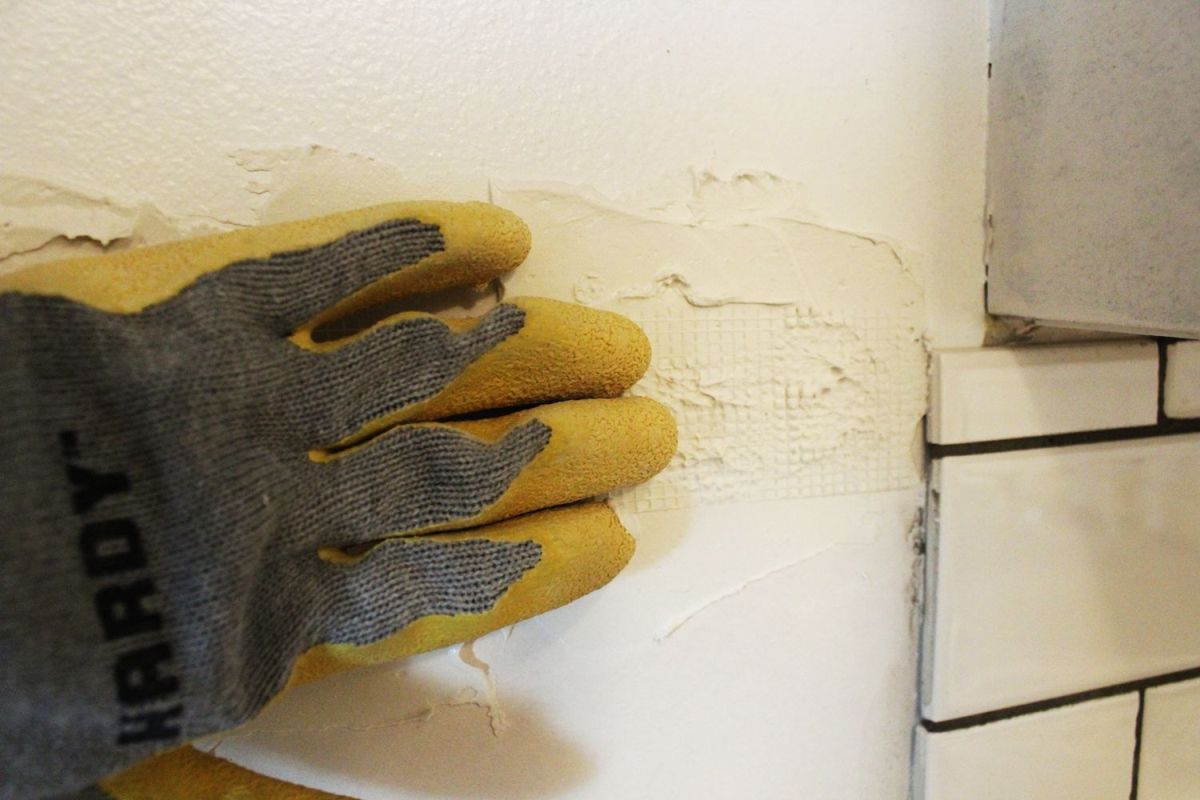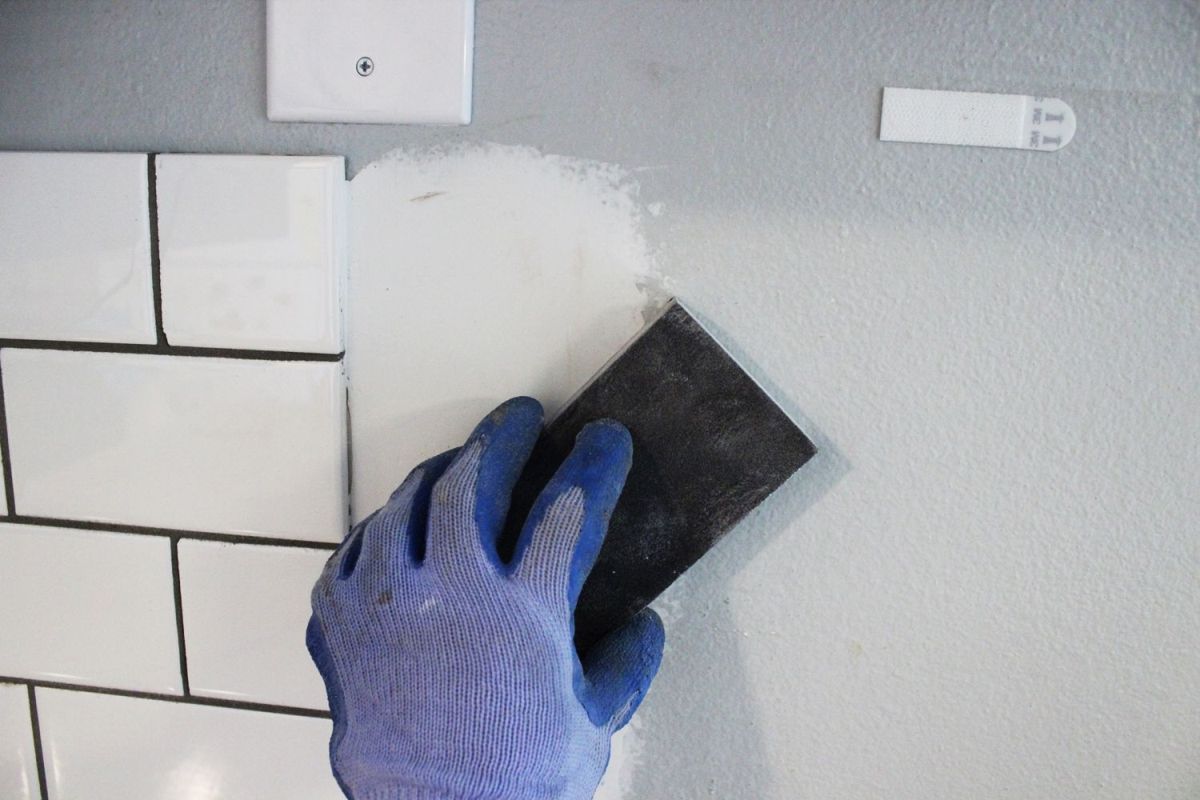How To Remove Backsplash And Repair Drywall
Nearly homeowners will need to install or repair some drywall at some point in their homeowning life. Information technology can exist quite intimidating, cut into the "peel" of your home.
 View in gallery
View in gallery Just if y'all're careful and aware of the basic ideas backside how to install drywall, it actually is pretty like shooting fish in a barrel. We like the idea of starting in an area similar a kitchen backsplash because, although you must mensurate and cut and install with care to provide a flat workable vertical surface, the bulk of your drywall work will be covered up with a gorgeous backsplash. Then it takes a chip of the force per unit area off, don't you recall?
 View in gallery
View in gallery Here'south a step-by-step guide on installing (or repairing) drywall, particularly aimed at doing information technology for a kitchen backsplash. (Of form, the general guidelines are the same pretty much anywhere, so this tutorial volition help you with most of your sheetrock-installing needs.) Please note that the photos throughout this commodity prove different sections of the kitchen's drywall, due to lighting and other photographic constraints.
DIY Level: Intermediate to install or repair a drywall
 View in gallery
View in gallery Materials you'll need to install or repair drywall:
- razor blade
- drywall screws and drill
- putty pocketknife / trowel
- joint compound (also known as "drywall mud")
- drywall tape
- sanding block – fine to medium
- spray texture
- primer& paint
How to install or repair drywall:
 View in gallery
View in gallery In lodge to be able to install drywall correctly, you'll need to make sure that all the vertical edges of the drywall itself tin can be screwed to a framing 2×4. Even if this means cut your sheetrock further than you might need, or want, to cut it.
The edge of the existing drywall in the photo above ends right at the edge of a ii×4 (which means i side of the drywall would exist "floating" freely – not adept), so we'll need to cut it back to the next framing stud.
 View in gallery
View in gallery The carmine line in the photo above represents where the 2×4 is. Notice we accept cut halfway over the 2×4, so both the remaining drywall and the new drywall piece can be screwed securely to the two×4.
 View in gallery
View in gallery You may utilize a razor blade (box cutter, x-acto pocketknife, whatever you telephone call information technology) to get a clean cut on the drywall.
 View in gallery
View in gallery Utilise a box cutter to cut the drywall corners make clean and square.
 View in gallery
View in gallery Make sure everything that would prohibit the new drywall from lying flat against the framing studs is gone. Take out whatsoever screws or nails, if in that location are any. Too scrape away whatever remainder gunk, including glue or whatever else. The 2x4s should be free and articulate.
 View in gallery
View in gallery In the event that you run into space where it'due south impossible to cutting the drywall at a halfway point on a stud (such as this infinite above the kitchen sink, for example, where the framing doesn't match up with the cupboards), you'll need to install 2×four back up.
 View in gallery
View in gallery Afterwards measuring the peak of your infinite as well every bit the distance from that space to the nearest framing stud, you lot'll need to cut 2x4s co-ordinate to those measurements. In this instance, that required an eighteen" 2×4 (for the pinnacle) and two 5" 2x4s (for the distance from the nearest two×4).
 View in gallery
View in gallery Begin by screwing in the two shorter pieces to the nearest framing stud. We used a diagonal screw management for zipper, ii screws per piece.
 View in gallery
View in gallery Side by side, you'll need to attach your 2×4 length to the ii shorter pieces yous just installed. Utilize a smash gun if you have one, or screws, or good former-fashioned hammer-and-nails.
 View in gallery
View in gallery As you can run into from the photo in a higher place, installing this 2×4 to the space volition allow the new drywall to be secured on the sides. This is disquisitional for long-term support; if a drywall edge is left floating, it will bend and warp and potentially crack…along with anything that is installed on acme of it (like backsplash tiles).
 View in gallery
View in gallery Repeat this pace in as many areas as you need to ensure 2×four framing support on the vertical axes of your new drywall.
 View in gallery
View in gallery At this point, yous are ready to measure, cut, and fit your new drywall pieces to your space. Drywall sheets typically come up in 8' lengths (12' lengths are available besides but are much more troublesome to ship and manage for the average homeowner).
Mensurate so that each drywall slice starts/ends on a stud, even if information technology means cut a niggling length off a longer drywall piece and adding in a second piece. Merely measure all walls.
The wall in the photo above, with the ruby-red line, measured viii' ½" long. Knowing this, nosotros were able to install the bordering drywall first, which took away ½" because the new drywall is ½" thick. This made the red line wall an exact eight' long – much easier to work with.
 View in gallery
View in gallery Measure and pencil in your measurements on the drywall. Use a box cutter to score the exposed (non-dark-brown) side of the sheetrock.
 View in gallery
View in gallery Carefully bend the sheetrock along the scored line.
 View in gallery
View in gallery Pull the sheetrock all the way downwardly to separate the inner stuff.
 View in gallery
View in gallery Keeping the sheetrock aptitude, you can apply a box cutter to cutting through the back layer. Try to keep your cuts clean, merely don't worry if they're non perfect or if the paper bankroll rips a trivial scrap. It shouldn't bear upon your install.
 View in gallery
View in gallery Along with measuring the sheetrock perimeter, you'll want to measure and cut out spaces for any electric switches or outlets. Over again, measure out, draw, and score these spaces.
 View in gallery
View in gallery Use a hammer or the back cease of a drywall pocketknife to popular out the center and create a drywall hole.
 View in gallery
View in gallery A drywall knife is the easiest tool to utilise here for cleaning upwardly your edges and corners.
 View in gallery
View in gallery Test-fit your drywall slice. Make sure all edges and corners lie flat and that any electrical considerations are made accurately. If the drywall doesn't lie affluent, pull it off and apply a drywall knife to "shave" the necessary edges until information technology does fit.
 View in gallery
View in gallery Aim for a fairly close fit around electric outlets and switches, although if you're a little off, it'southward okay. Recollect that the electric plate will cover upward a little of the edge, so you accept a bit of a safety zone.
 View in gallery
View in gallery Corners are good here. If your corners aren't lying flat, double check to make sure the old drywall corner is cutting clean; it's easy to overlook an old hunk of drywall in the corners, which keeps the new piece from lying flush.
 View in gallery
View in gallery When all looks good, pull the drywall away from the wall just a couple of inches so you can mark the studs. This makes information technology much faster and easier to screw the drywall in once it's upwardly there for practiced.
 View in gallery
View in gallery Spiral in the new piece of drywall along the studs that you lot've marked.
 View in gallery
View in gallery Mensurate advisedly and cut advisedly, and your drywall should become up adequately easily and quickly. If there are gaps between your drywall pieces just you're planning on installing a backsplash over them, you won't even demand to worry about taping and mudding them.
 View in gallery
View in gallery When the drywall is screwed into place, it's time to mud and record. You'll want some drywall tape, joint compound (also known equally drywall mud), a fine to medium sanding block, a putty knife and larger trowel, and gloves (optional).
 View in gallery
View in gallery If y'all've never done this before and accept the option, choose a section of drywall that's somewhat subconscious to be your "exercise" section. This item department is behind the refrigerator.
 View in gallery
View in gallery Brainstorm by spreading your joint compound over the cracks.
 View in gallery
View in gallery The goal here is to fill the crack enough to create a smooth, seamless surface.
 View in gallery
View in gallery Yous can also utilize a larger trowel-type spreader for the mud. A larger i such equally this helps to smooth the mud more cleanly.
 View in gallery
View in gallery You desire the joint chemical compound to be thick enough to exist able to sand downwardly later, but not so thick that it takes forever to sand down later.
 View in gallery
View in gallery Cut a slice of drywall tape that'southward long plenty to run forth ane seam, from one corner to another.
Related: Best Drywall Patch Kit for Your Abode Repair Projects
 View in gallery
View in gallery Place the tape gently on the wet joint compound directly over the seam.
 View in gallery
View in gallery Push the tape into the articulation compound. You desire all the mesh to sink into the compound, creating a stiff back up when the chemical compound dries.
 View in gallery
View in gallery Subsequently the tape is pushed into the chemical compound, put a little more wet compound onto your putty knife and run information technology over the tape again.
 View in gallery
View in gallery Doing this might expose some of the record'south "grid" lines.
 View in gallery
View in gallery Add a little more than compound so those filigree lines are covered upward, but add just plenty to comprehend them (non too much – you desire layers to exist as thin every bit possible).
 View in gallery
View in gallery Let joint compound dry out. Information technology make accept a while – even 24 hours, depending on the thickness of the mud.
 View in gallery
View in gallery When joint compound is completely dry, gently sand it smooth with a fine sanding block.
 View in gallery
View in gallery Tip: Angle the cake to taper the joint compound toward the wall so as to minimize the possibility of exposing the drywall tape.
 View in gallery
View in gallery If you detect irregularities, pockets, cracks, or if the drywall tape filigree is exposed, repeat the awarding steps with very thin coats until the wall is smooth and seamless.
 View in gallery
View in gallery This is a messy procedure; be sure to vacuum your workspace equally you get then as to avoid tracking the mud dust everywhere.
 View in gallery
View in gallery If your walls are textured, y'all'll need to friction match the flat new drywall to the rest of your walls by adding like texture. To practise this, begin past taping off any nearby surfaces that you DON'T want textured. This includes countertops, backsplashes, cabinets, etc. Even electrical outlets and similar should be covered.
 View in gallery
View in gallery Spray textures are available at your local habitation improvement store. These are two examples. I have plant both to work equally well.
Related: Don't Settle for Drywall –Go for These Crawly Finishes Instead
 View in gallery
View in gallery Adjust the settings on your spray texture every bit per the can'southward instructions, then practise spraying on a not-wall surface. When you take the right spray, you're ready to do the wall.
 View in gallery
View in gallery Make several light passes with the spray texture over the new drywall surface, keeping the spray can about 2 anxiety away from your wall. (The method is similar to spray painting – do quick, lite strokes. Y'all tin always fill in more subsequently.) When your texture matches the surrounding walls, stop spraying and let information technology dry.
 View in gallery
View in gallery Prime and paint the newly drywalled and textured wall. Congratulations on your seamless drywall installation!
Note: The author is an experienced, although not professional person, habitation comeback enthusiast. Homedit is not responsible for any injuries or damages acquired equally a result of this tutorial.
How To Remove Backsplash And Repair Drywall,
Source: https://www.homedit.com/install-or-repair-drywall/
Posted by: lathamwormse.blogspot.com


0 Response to "How To Remove Backsplash And Repair Drywall"
Post a Comment